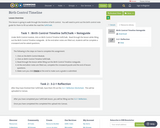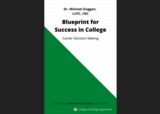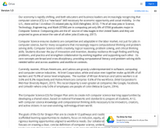
Draft of 1.1
- Subject:
- Applied Science
- Material Type:
- Activity/Lab
- Date Added:
- 05/31/2018


Draft of 1.1

This project is a fun way for students to think about the four elements of the marketing mix through research of a product/service and breaking it down to examine each element.

In this lesson, students will learn about the five love languages. Students will be able to identify them, and will learn how to apply them in various relationships. Students will take the quiz to learn their top love language and will reflect on how they will apply this information to bettering their life.

Course PurposeWelcome to AJS-200 Current Issues in Criminal JusticeIn this course, we will be studying the major current issues facing the criminal justice system. We will use as our starting point the 2015 President's 21st Century Policing Task Force report on the police. This report came about after the death of Michael Brown, shot and killed by a Ferguson Missouri police officer. Many of the significant challenges to the way policing is carried out today came about following that one event. This course will allow you the student to examine the different calls for police reform and research the pros and cons of each. This course is an OER course meaning that there is NO TEXTBOOK to purchase. Instead, we will identify and use as our training material the governmental documents and other open resource documents on the internet to gain our insights into the topic of each week.

BSA 110 -- Personal FinanceWelcome to the wonderful world of Finance (and money)!! The course is a 8 weeks, you need to keep up with the Modules. There are 8 Modules, so we will complete one module every week.Personal Finance refers to how you manage your money, including your income, expenses, and savings. When you put effort into managing your personal finances, you have a better grasp on where your money is going and what changes you can make to meet your future financial goals. Your Personal Finances are crucial in almost all aspects of your life. How you handle your credit, what is your purchasing power, and am I prepared for retirement? What are my short- and long-term financial needs?We will be looking at many different topics: Investing, The Fed, Stocks, Mutual Funds, and Retirement, to name a few.

Video and study guides for the following topics: Order of operations, algebraic manipulation, negative and fractional exponents, rounding, engineering notation, unit conversion, general industrial safety, energy, power, efficiency, capacity factor, basic electrical properties: voltage, current, resistance, fixed resistors, variable resistors, protoboards, ohmmeters, series resistors, parallel resistors, 4 band resistor color code, DC Ohm’s Law, DC power, voltmeters, ammeters, series DC circuit properties, DC Kirchhoff’s Voltage Law, DC voltage divider rule, parallel DC circuit properties, DC Kirchhoff’s Current Law, DC current divider rule, series-parallel DC circuit properties, instrument loading effects, DC current sources, source conversion, resistive delta-Y conversion, complex DC circuits, DC Superposition Theorem, DC Thevenin’s Theorem, DC Maximum Power Transfer Theorem, DC Norton’s Theorem

This course is the 2nd in a three part series intended to support the flipped classroom approach for traditional basic electronics classes. Basic Electronics 2 covers capacitors and the transient capacitor charge and discharge process, inductors and the transient inductor storage and release process, sinusoidal properties, complex numbers and complex impedance, phasors, AC Ohm’s Law, series AC circuit analysis, parallel AC circuit analysis, and series-parallel AC circuit analysis. The text includes discussions of Kirchhoff’s Voltage Law, the AC Voltage Divider Rule, Kirchhoff’s Current Law, and the AC Current Divider Rule. Additionally the text covers use of AC voltmeters, AC ammeters, function generators, and oscilloscopes. These resources are meant to accompany a hands on lab with the guidance of an instructor.

This course is the 3rd installment in a three part series intended to support the flipped classroom approach for traditional basic electronics classes. Basic Electronics 3 covers apparent, real, and reactive power and power factor, power factor correction, ideal and non-ideal transformers, and transformer connection diagrams, AC circuit analysis techniques and theorems like source conversion, the AC superposition theorem, AC Thevenin’s Theorem, and the AC Maximum Power Transfer Theorem, 3 phase AC systems including balanced and unbalanced 4 wire Y configurations, 3 wire Y configurations, and delta configurations, the single wattmeter method and the two wattmeter method. These resources are meant to accompany a hands on lab with the guidance of an instructor.

This readily accessible online introductory resource was developed for anyone who has interest in, or works with, HVAC controls and equipment. Designed for electrical and HVAC apprentices learning about the subject in school, you will find the descriptive text and original diagrams easy to navigate through, while the question bank will help students review the subject matter covered in each section.

This lesson is going to walk through the timeline of birth control. You will need to print out the birth control note guide for them to fill out while the read the SoftChalk.

Career Development at College of DuPage
Word Count: 29580
(Note: This resource's metadata has been created automatically by reformatting and/or combining the information that the author initially provided as part of a bulk import process.)

The Center for Strengthening the Teaching Profession – Teacher Tech Project provides information, resources and learning opportunities for teachers to develop their knowledge, skills and understanding of Learning Management Systems and instructional design for distance learning.

The Computer Science (CS) for Oregon Plan aims to create rich computer science learning opportunities bydeveloping a shared vision, based on national frameworks and standards to prepare all students, K-12,with computer science knowledge and computational thinking skills necessary to be innovators, creators,and active citizens in our ever-evolving, technology-driven world.
The goals of the CS for Oregon Plan are to create K-12 pathways and roadmaps that provide cohesive,scaffolded learning opportunities to students, focus on inclusion, equity, and access for all, and supportrigorous learning opportunities aligned to workforce needs. Our collaborative, multi-district approachfocuses on creating a clear, concise definition of computer science, understanding the current CSlandscape including barriers and opportunities, evaluating the K12CS framework and its associatedstandards, developing key learning indicators per grade-band mapped to the national framework,connecting educators to aligned resources and associated professional development opportunities,documenting and sharing sample strategies for creating opportunity for all students, and developing andimplementing action plans. As such, the CS for Oregon Plan’s intended audiences are principals,superintendents, STEM/CTE leaders, educators, school counselors, grant managers and foundations, theOregon Department of Education, the Chief Education Office, and legislators. Our advisory group,providing direction and feedback, is comprised of education, non-profit, industry, and state leaders.This work is licensed under a Creative Commons Attribution-NonCommercial-ShareAlike 4.0 International License.

This task was developed by high school and postsecondary mathematics and agriculture sciences educators, and validated by content experts in the Common Core State Standards in mathematics and the National Career Clusters Knowledge & Skills Statements. It was developed with the purpose of demonstrating how the Common Core and CTE Knowledge & Skills Statements can be integrated into classroom learning - and to provide classroom teachers with a truly authentic task for either mathematics or CTE courses.

This task was developed by high school and postsecondary mathematics and agriculture sciences educators, and validated by content experts in the Common Core State Standards in mathematics and the National Career Clusters Knowledge & Skills Statements. It was developed with the purpose of demonstrating how the Common Core and CTE Knowledge & Skills Statements can be integrated into classroom learning - and to provide classroom teachers with a truly authentic task for either mathematics or CTE courses.

This task was developed by high school and postsecondary mathematics and agriculture sciences educators, and validated by content experts in the Common Core State Standards in mathematics and the National Career Clusters Knowledge & Skills Statements. It was developed with the purpose of demonstrating how the Common Core and CTE Knowledge & Skills Statements can be integrated into classroom learning - and to provide classroom teachers with a truly authentic task for either mathematics or CTE courses.

This task was developed by high school and postsecondary mathematics and agriculture sciences educators, and validated by content experts in the Common Core State Standards in mathematics and the National Career Clusters Knowledge & Skills Statements. It was developed with the purpose of demonstrating how the Common Core and CTE Knowledge & Skills Statements can be integrated into classroom learning - and to provide classroom teachers with a truly authentic task for either mathematics or CTE courses.

This task was developed by high school and postsecondary mathematics and agriculture sciences educators, and validated by content experts in the Common Core State Standards in mathematics and the National Career Clusters Knowledge & Skills Statements. It was developed with the purpose of demonstrating how the Common Core and CTE Knowledge & Skills Statements can be integrated into classroom learning - and to provide classroom teachers with a truly authentic task for either mathematics or CTE courses.

This task was developed by high school and postsecondary mathematics and agriculture sciences educators, and validated by content experts in the Common Core State Standards in mathematics and the National Career Clusters Knowledge & Skills Statements. It was developed with the purpose of demonstrating how the Common Core and CTE Knowledge & Skills Statements can be integrated into classroom learning - and to provide classroom teachers with a truly authentic task for either mathematics or CTE courses.

This task was developed by high school and postsecondary mathematics and design/pre-construction educators, and validated by content experts in the Common Core State Standards in mathematics and the National Career Clusters Knowledge & Skills Statements. It was developed with the purpose of demonstrating how the Common Core and CTE Knowledge & Skills Statements can be integrated into classroom learning - and to provide classroom teachers with a truly authentic task for either mathematics or CTE courses.